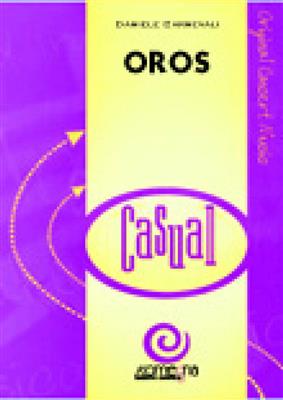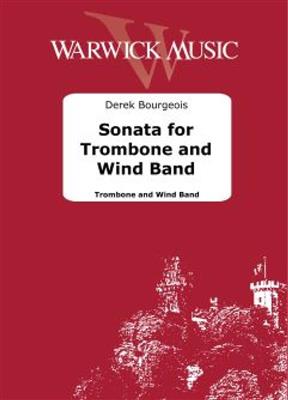Results
-
 £63.99
£63.99Nurture - Edward Fairlie
There are some people for whom the act of nurturing is innate.The work they do is often unheralded, acknowledgement of their effort the last thing on their mind. But nurturers carry pain, too. Their own burdens, anxieties andhardships often take a back seatto that nurturing impulse. This piece is a meditation on that idea: that some people, not without their own deep personal obstacles, can't help but live out the powerful instinct to hold thosearound them in a warm embrace of care. ~Edward Fairlie Dur: 4:50 (Recorded by the Eltham High School Symphonic Band, directed by Rick Plummer, guest conductor Edward Fairlie)
Estimated dispatch 7-14 working days
-
 £228.70
£228.70Reflections - Suite on a Norwegian Folk Tune - John Brakstad
The suite is constructed around a Norwegian folk tune. The melody is called "Dark Forebodings", and the words of the song revolve around thoughts and reflections on a future that can take unexpected, insecure, or perhaps dramatic and tragic turns.This is essentially a sad song with a beautiful melody. The folk tune itself is presented in the 2nd movement. In the 1st movement, the folk tune is joined with fleeting themes that indicate the unexpected; as if the music sometimesis confused as to which way to go. There are constant changes in atmosphere and feeling, from the harsh and dissonant, to the harmonious and melodic. The 3rd movement presents a more lively variant of thefolk tune, showing optimism andhappiness, even though the "halting" character of the rhythm underscores the unpredictable. The title "Reflections", therefore, refers to thoughts we can have about life. To the Conductor:The 2nd movement has an alternativeending which is may be used if the movement is played as an independent lyrical piece in a concert.It is advisable to begin first rehersal with the 2nd movement so that the main theme is known, before beginning on the 1st movement with itsmore semi-tonal parts. Intervals and intonation can provide much of the challenge in this movement.The 3rd movement can be more technically challenging, but there is considerable leeway in the tempo marking! It is important to maintain theenergy and intensity of the music through the whole movement.
Estimated dispatch 7-14 working days
-
 £91.20
£91.20San Patrizio - Lorenzo Pusceddu
Since 1166, the only sanctuary in Italy dedicated to the memory of Saint Patrick has sat in Colzate. Numerous people visit this sacred place every year, also to admire the extraordinary view from its portico and the luxurious nature that surrounds it. The sanctuary seems to be shaped by nature itself, as its walls blend with the rock on which it rests. The building of this sacred place is associated with the trade relations that the inhabitants of the Seriana Valley shared with merchants from Ireland. It took centuries for the sanctuary to become what we see today: the construction of its nucleus began in the 12th century and ended with the erection of the current portico. This composition depicts in music the veneration that the people of Colzate and neighboring villages have for Saint Patrick. The ternary form recalls the symbol of the clover (in Gaelic Shamrock), with which Saint Patrick explained the Trinity to the people of Ireland.
Estimated dispatch 7-14 working days
-
 £135.80
£135.80Ad Quartum - Luciano Feliciani
The city of Quart derives its name from the Latin "Ad quartum ab Augusta lapidem", or four Roman miles from Augusta Praetoria, present-day Aosta, along the ancient Roman consular road of the Gauls. The fortress of Quart, whose construction began in 1185, is the main source of inspiration for the composition. The work begins, in fact, as if wrapped in a mysterious, suspended atmosphere, when the fog that envelops the manor suddenly thins out and lets one see the majestic building in all its austerity. A rhythmically exciting episode follows this brief introduction, ideally describing the events that have marked the long history of these places. The music highlights the percussion instruments, which evoke ancient medieval atmospheres in a modern language. The second theme, derived from the previous one, describes instead emotions and feelings of grandeur, beauty, and peace associated with the splendid Valle d'Aosta mountains that surround Quart. A developed melodic idea, supported by wide-ranging harmonies, attempts to musically portray the extraordinary natural beauty of these places. The reprise of the first theme, varied and presented in a lively and energetic movement, guides the final part of the piece: a coda where all the melodic and rhythmic ideas previously exposed are condensed.
Estimated dispatch 7-14 working days
-
 £113.30
£113.30Via Della Terra - Marco Somadossi
Composing music also involves being able to imagine the sound of something that has no sound of its own. "Via della Terra" is a soundtrack without a film, a story without a narrator; "Via della Terra" is a street in a town, but not just any street, because if a street could tell its story, "Via della Terra" would not know where to start or where and indeed if it should finish. Like all "Vie della Terra", this street in this piece is full of sounds, none of which, however, have ever belonged to it for more than a fleeting moment, just long enough to be reflected here and there and then up and away from the earth, to be lost in the air. The steps of Mozart as a child as he whistled a piece of music, never again to be remembered or written; the philosophical thoughts, or mere everyday cares, uttered to a friend by Rosmini (whispered? or declaimed?); the excited or humorous comments of people who saw Depero's futuristic works for the first time; the voices of marketstall owners, rendered louder and more acute by the noisy crowd of women sorting through the stalls of rustling and colourful silk (so many desires; silent pauses between one item of gossip and the next); the absolute and devastating roar of cannons that violated every corner of the town, injuring bodies and mutilating the memories of its inhabitants... followed by a seeming eternity, as the citizens held their breath, waiting... "Via della Terra" is the old imperial road along which the town of Rovereto was built and has developed. "Via della Terra" is music for an imaginary, impossible and simultaneous representation of all its stories. The composer has always lived in this town, which he dearly loves, and on innumerable occasions he has imagined the voices, smells, people and the lives that have been such a part of it. With his composition, "Via della Terra", Marco Somadossi won second prize (no first prize was awarded) at the XXI Corciano International Competition for original band music in the grade 4 category.
Estimated dispatch 7-14 working days
-
 £105.80
£105.80Oros, Little Suite - Daniele Carnevali
This piece was commissioned for the second edition of the "Suoni d'Aspromonte" National Competition which is held in Cittanova in the province of Reggio Calabria. The title, Oros, from the ancient Greek word for "mount", is a clear reference to the Greek culture that colonised Calabria and the magnificence of the Aspromonte massif that dominates the entire region: forests, towns and sea. The piece consists of three movements: Entrata, Serenata and Corteggio, offering rhythms and melodies that reflect present-day tastes rather than local musical traditions. It is specifically intended for bands with lots of young members.
Estimated dispatch 7-14 working days
-
 £113.30
£113.30Caleidoscopio - Lorenzo Pusceddu
The incommunicability between different cultures and worlds and the confusion that this generates lie at the heart of this work: the fanfare-like themes that characterise the introduction, together with the "Arabian" melodies of the Presto, represent these differences. The bare theme of the Andante, while offering a glimpse of hope, also describes the impossibility of a meeting and the pain this situation causes. The empty fifth and dissonance of the minor second are elements that feature throughout this work. In the Coda, moreover, all these ideas reappear "kaleidoscopically", amidst a convulsive and excitingly chaotic atmosphere.
Estimated dispatch 7-14 working days
-
 £110.00
£110.00Mount Everest - Kees Vlak
This composition basically consists of three fragments and an epilogue (conclusion):1) Plateaux, 2) Sherpas, 3) Climb. The piece starts with a musical depiction of the deserted plateauxs and mountain peaks of the Himalayas. The mysteriousness of theTibetan country was caused by its inaccessibility to other nations. One even believed that there was a paradise behind the huge mountains; the land of Shangra La. 1) After the sound of a gong, the Asian-like theme arises extremely softly from thedecay of the percussion. In bars 4 and 5 the syllables of Hi-ma-la-ya echo. Then a second theme appears; it symbolises the enchantment of the mountaineers by seeing the Mount Everest. 2) Eastern percussion, very evenly without emotion, sound from thedeserted village of the sherpas. The phrasing is prescribed by the number 'three'. From measure 56 Tibetian monks sing a chant, also with the religious background of the number 'three'. 3) The third part starts of with the sight of the giant MountEverest with an entirely new theme, that is played impressively by the strong low brass instruments of the band, immediately followed by the excited big climbing. The many surprises are depicted by the changing time signatures. Two themes are inconstant battle; the binary Himalaya theme and the ternary Mount Everest theme. Only once there is a steely composure. The registers in which the piece is played increase. The tension rises...Then the peak is reached. A long pause follows before onerealises that one is on top of the world. Slowly the emotions of joy grow and lead to an enormous climax. The first enchanted theme sounds again in total glory.
Estimated dispatch 7-14 working days
-
 £75.00
£75.00Sonata - Derek Bourgeois
This work, composed in 1998, was commissioned by the American trombonist Don Lucas as a work for trombone and piano and first performed by him in Birmingham on 19th May 2000. Subsequently, I arranged the music for both solo trombone and brass band and solo trombone and wind band so that it now exists in three formats. The first movement, in B flat major, is brisk and energetic, and is cast in sonata form. The second subject is gentler and more lyrical. The second movement, a scherzo in C major, is the most complex of the four. Basically the structure is a rond. For a long time the music remains in the opening 5/8 time until a new theme introduces more broken rhythms in a more jazzy idiom. After a return of the opening theme the following episode is more tonally ambiguous. Finally, the main theme returns to round off the movement. The third movement, a lyrical adagio, is really one long extended melodic flow. The harmonies are lush and the textures simple and direct. The tonal center is A minor, but the music meanders through so many keys, that this key centre is heavily disguised. The finale is a fiery affair. G minor is really its home key, but throughout the movement the music moves about a lot and the second subject is first heard in A flat minor. The movement's underlying sonata structure is masked not only by its loose tonality but also by its frequently changing time signatures. Like the first movement the second subject is more lyrical in nature and for a while it seems that the music will end peacefully, but a final flurry heralds a triple forte unison on the home note of the first movement - B flat. Derek Bourgeois
Estimated dispatch 7-14 working days
-
 £104.50
£104.50From Four and Beyond - Gary P. Gilroy
This composition is based on a four-note motif that has a decidely collegiate feel, complete with a reflective statement that quotes Troy High Schools alma mater. This is an exciting work that will be enjoyed by experienced bands and their audiences.
Estimated dispatch 7-14 working days
